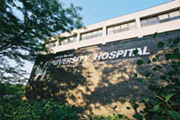Lesser of Two Evils
At 8 a.m. Eastern Daylight Time on Wednesday, October 24, 2012, Tropical Storm Sandy became a hurricane. The storm was 80 miles south of Kingston, Jamaica. Most weather models at that point anticipated Sandy moving harmlessly out to sea. Nevertheless, emergency management officials along the eastern seaboard kept an eye on the storm. By the next morning, some models began showing the hurricane approaching the New York-New Jersey area.

Staten Island University Hospital - South Site
Image courtesy of North-Shore LIJ
Fourteen months after Irene, Romagnoli and Solazzo were once again dealing with the threat of a hurricane hitting the New York metropolitan area. "Something we never thought either one of us would ever do—second year in a row," says Romagnoli. North Shore-LIJ's Incident Command team began preparing. They ordered a rapid discharge at Staten Island University Hospitals North and South and Southside Hospital. They transferred high-risk patients—mechanically dependent and neonatal patients—to other facilities in the system. "We decompressed the hospitals as much as we could," says Romagnoli.
The hospitals canceled elective procedures and accelerated the schedules for dialysis and infusion patients to ensure they wouldn't face delays in treatment if the storm disrupted services. They had home care nurses make all their visits in advance of the storm. They closely monitored their in-house weather service. They also prepared the facilities. "We pre-stocked supplies, we topped off everything, we tested everything," says Solazzo.
With the threat of a storm surge foremost in their minds, the Incident Command team prepared the three hospitals for flooding. They sandbagged the buildings and the generator complexes and positioned pumper trucks to be ready should floodwaters breach the sandbags. If Sandy turned out to be worse than Irene, the hospitals had multiple lines of defense, says Solazzo.
Prepared. North Shore-LIJ had "decompressed" Staten Island University Hospitals North and South and Southside Hospital. They had discharged patients who could be sent home and transferred those most vulnerable to power outages and other disruptions, reducing the patient population at the three at-risk hospitals by about half. The question now was what to do about the remaining 573 patients?
If Sandy played out like Irene, there would be no need to evacuate. But how can they know 48 hours in advance? Irene had been menacing right up until it reached shore. What if Sandy was worse than Irene? How much stronger than Irene could a storm be before it posed a threat to the hospitals? The time had come for Solazzo and Romagnoli to make their call. "As I’m trying to make the decision [whether] to evacuate, I’ve got two things weighing on me," says Solazzo:
One is that it went very well before, so I know we can do it. But two was trying to assess the storm surge, because that was the thing that was most critical. We were checking in probably three or four times a day with the people in the state [and] with the weather forecasters we work with to understand the storm surge.
Looking back at Irene, Romagnoli was convinced that North Shore-LIJ could have gotten away without evacuating. Forecasts for Sandy at that point projected a storm surge comparable to Irene's, maybe a little worse, he says. "Evacuation is still my last resort. I really don’t want to do it unless I absolutely have to."